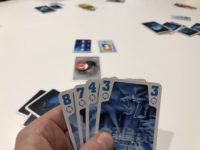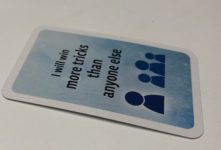- Learning time
- 10 minutes
- First play time
- 20 minutes
The Crew: Mission Deep Sea
Designed by: Thomas Sing
Mission Deep Sea follows the same principles as The Crew: The Quest for Planet Nine. Both use the classic deck-of-cards mechanic of trick-taking: all players play a card, and the highest card takes the played cards as a ‘trick’. Like standard trick-taking, you must follow suit if you can. But like it’s space-questing predecessor, players work co-operatively to complete missions: you win or lose as a collective.
In the box is a rulebook and a series of missions you can play in any order you like, but they ramp up the difficulty so experiencing them chronologically makes sense. All the cards are dealt out to the players: there are several suits numbered 1-9 but the trump suit – the strongest – only runs from 1-4. The player who is dealt the 4 is the captain and begins play by taking – or not taking! – a task: before any tricks are played, players have to assign some tasks – only by completing them is the mission a success!
A task might be as simple as I will win the first trick. It might be a little harder, such as I will win no green cards. Or it might be very hard indeed, eg I will win the just the last three tricks. The early missions might have one or two tasks, but as you progress through them you’ll find not only are the tasks harder, but there are more of them.
Play proceeds with the captain playing the first card and everyone else a card of their own – standard trick-taking rules apply – and the winner of that trick starting the next trick. Play continues in this fashion until either all tasks are completed or the players have either not, or are clearly not going to, complete them. If you succeed, you can move on to the next mission – if you fail, then you attempt the same mission again.
But!
The critical rule in this game – as with its big sister – is that players are extremely restricted in what they can communicate about their hand of cards. Everyone has one communication token they can use – at most: some missions don’t allow any communication! – once during a mission. You may place a single card face up on the table of any suit (except trumps) and place the communication token at the top (meaning this is my highest card in this suit) the bottom (this is my lowest card in this suit) or middle (this is my only card in this suit). Which sounds very limiting, of course. But use of the communication tokens is very often the key to success, as it allows just enough information to change hands to navigate the tasks successfully.
The guru's verdict
-
Take That!
Take That!
None - everyone is working as a team toward a set of common goals.
-
Fidget Factor!
Fidget Factor!
Low to moderate, depending on who's playing and how tricky the particular mission is.
-
Brain Burn!
Brain Burn!
The rules are very straightforward. The brain-burning is how best to employ them in order to finish the various tasks.
-
Again Again!
Again Again!
There are huge amount of task cards, so not only are there multiple missions to complete, but they also differ each time you attempt them.








Sam says
I was really impressed with The Crew: Quest for Planet Nine when I first played it, and I think the Deep Sea iteration is even better: more nuance to play, more variety in tasks and more fun as a result. That said, I think I have to be honest and say that after repeat plays, both games err a little too far toward the brow-furrowing type of play for me. There's nothing inherently wrong with that at all - and I can still enjoy them for what they are. But in games I like a tangible theme, laughter, surprises, story, maybe a bit of luck-pushing, and both Crew games aren't really ticking the boxes for me in those regards. I do still think they're extremely clever designs - but my experience of them is a kind of abstracted puzzle that leaves me more impressed than enthused.